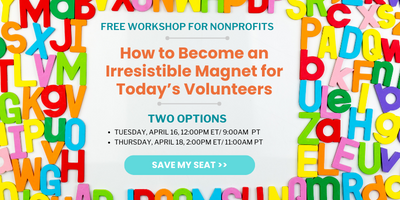 Community Service Projects: The Complete Guide for Nonprofits
Community Service Projects: The Complete Guide for Nonprofits
Court-ordered, school-based, scholarship required – it appears that mandatory community service projects are here to stay. In this post, we’ll share what you need to do to smoothly integrate community service into your volunteer offerings (or, decide that it isn’t a fit for you).
But, before we get started, let’s address the elephant in the room, right off the bat.
There has been plenty of debate by education experts as to whether they are beneficial or even ethical. There has also been broad agreement that the quality of a service experience has an impact on whether volunteers find them rewarding and if they then promote future volunteerism.
Regardless of your point of view, its existence can’t be ignored. So, it’s time to develop a solid approach for your nonprofit.
A Step-by-Step Guide to Establishing Community Service Projects at Your Nonprofit
There’s no way around it, mandatory community service is different than volunteerism that is freely chosen and given. Simply because volunteers are being “voluntold” doesn’t mean the experience shouldn’t be designed well.
Consider the following steps to decide whether your organization should take the leap and, if so, how you can develop a program you can be proud of.
STEP ONE: Establish a Policy
It’s important that your agency, not the volunteer department on its own, to decide if mandated community service is something they want to support. Certainly, volunteer services should advise on the decision, but because this decision involves human resources, the organization’s philosophy and policy should be decided by your governing body.
When considering or establishing an agency-wide policy around community service, ask these questions:
- Does mandated community service align with our organization’s mission and vision?
The answer will vary by organization. If you are a youth development organization, then community service may make complete sense. If you are a civil rights organization, it may not.
The important thing is that there is a robust discussion around whether the purpose and intent behind community service and whether it aligns with the foundational values of your organization. To free up staff to move forward (or not), your organization needs to take a stand one way or the other.
- What kinds of community service will we support?
Volunteers from several different types of organizations in your community are seeking service opportunities right now. And, each kind of sponsoring organization has different requirements.
Your organization must decide what kinds of volunteers will be accepted so that you can clearly communicate to the public what opportunities you have to offer and then set up the kinds of support and supervision that is needed.
Here are some common types of community service that are often mandated or strongly suggested:
- Court-ordered Community Service — Community restitution or “alternative sentencing” as a form of punishment intended to benefit the community that’s been harmed by an offender’s crime; there must be a direct connection between that service and the crime
- Medicaid Work and Community Engagement —Some states require non-elderly, non-pregnant, and non-disabled adults to either work or volunteer to qualify for Medicaid coverage
- School-based Service Learning — Emphasizes the educational aspect of the experience for the student and often includes self-reflection activities
- Community Service for Youth and Young Adults — May be required for graduation, used to make college applications more competitive, or to receive or maintain an educational scholarship; project ideas are often initiated by the student themselves
STEP TWO: Design for Quality Involvement
As with other volunteer roles, to get the most out of community service projects they must be thoughtfully planned and administered so that they are a win for everyone.
Here are a few questions to consider:
- What kinds of community service projects will we make available?
While community service may be mandatory for the individual, it is not for your organization. As with any volunteer opportunity, it’s vital that you weigh the potential costs and rewards of involvement.
Both your organization’s current needs and your existing supervisory capacity needs to be reviewed. The benefits to volunteers are also important. Rather than creating “busy work” that doesn’t benefit the volunteer or your agency, consider which projects could help you move the needle forward.
Community service requirements are related to the satisfactory completion of a minimum number of hours. So, by their very nature, they are project-based. If you want some ideas for student service-learning projects, see my recent blog post with examples of nonprofit projects in our local area.
Also, here are a few that might benefit your nonprofit:
- Buddy up with a more experienced volunteer and help, as needed
- Clean up or beautification of your landscape or offices
- Assist staff at a special event
- Decorate (or take them down) around the holidays
- Help with non-sensitive administrative work (data entry, bulk mailings, filing, etc.)
- Assemble toolkits, backpacks, training binders, goodie bags, or other items
- Work the reception desk and make reminder calls
- Conduct research projects and data analysis
- Conduct other short-term activities (teach computer skills, read to kids, help with foreign language interpretation, develop a welcome packet, design marketing materials, etc.)
Remember, the volunteer also must be comfortable with the task, have the skills to complete it, or receive the training and support to be successful.
- Do we have realistic expectations for this complex kind of relationship?
Make no mistake, this is a transactional relationship. Although it’s nice when community service volunteers stick around, don’t expect it. When they reach their threshold of required hours, they have completed their part of the agreement.
What’s more, volunteers may not see the value of service. They may even feel resentful that they are required to show up. Hence, you may be more likely to encounter attendance and motivation issues you don’t with other volunteers.
On the other hand, you may find that the experience evolves into something inspiring and transformational in nature. If the experience is designed well, and volunteers find your organization a friendly supportive place, there’s a higher likelihood this will occur.
Regardless, it’s important to recognize that the volunteers involved in this kind of service are often in the middle of an important personal journey. They’re headed to another place (a new school, graduation, re-entry into the community, etc.) and may not have time to devote to further service at the moment and may be with you for only a short season, and that’s just fine.
- What will be the application and onboarding requirements for community service volunteers?
As with any other volunteer role, conducting a thorough risk management process makes sense.
There are many benefits of risk management. Most important is that you are able to predict and mitigate harm through thoughtful, proactive management and program design. It’s not about doing less (or keeping people out); it’s about doing more (and bringing people in). But, you must do so with your eyes wide open.
While background screening is often the first risk management activity to come to mind, it’s not the only one to consider. If you’re wondering what others are doing for their volunteer screening activities, see my blog post on empowered background checks.
If you’re worried that you may not be applying your background screening in a fair and legal way, check out my post on the three top risk management mistakes for some things to consider.
STEP THREE: Set Everyone Up for Success
 Finally, if you invest valuable time in developing a solid community service program, why not do all you can to develop it into a real asset for your organization, rather than simply a “nice to have” project?
Finally, if you invest valuable time in developing a solid community service program, why not do all you can to develop it into a real asset for your organization, rather than simply a “nice to have” project?
- With which local organizations might you partner for community service projects?
If you’re like most nonprofit staff, you have little time to waste on tasks that don’t drive your mission forward. Mandated community service projects are no different and should be leveraged accordingly.
That means you must also develop strong partnerships with referring organizations, so they understand your organization’s requirements and limits. It’s also vital that you are clear about their policies, needs, and participant rules and have a plan in place to manage the reporting requirements.
As with any collaboration, it’s essential that you memorialize the partnership with a written agreement that specifies the goals of the relationship, the requirements and logistics for service placements, and how problems will be addressed when they occur. It’s helpful to renew and refresh these agreements annually as the partnership evolves and you earn together what works best and what you want to leave behind.
- When will we make community service projects available?
Through discussions with sponsoring organizations, you can quickly discern the optimal timelines for community service projects. They may be predictable or seasonal (think: school semesters or summer projects) or may be completely random (think: when the court decides). It will be important to know where these projects will fall into your calendar.
It’s also important for your organization to consider when is the most opportune time to accept new community service volunteers. At what times of the year, do you have the capacity to train and supervise these kinds of projects? Does this align with when these volunteers most likely are seeking opportunities?
If designed and managed well, community service projects that are consistent, predictable, and repeatable have high potential. They can offer a targeted influx of people power to help support important recurring needs for your organization.
They can also build confidence, connection, a sense of community, and civic pride for volunteers, making these projects a win-win for everyone.
What Community Service Projects Have You Tried?
We’d love to hear your personal experiences with mandated community service volunteers.
Where have you found the most success? What has been challenging?
What are your keys to better results? What needs to be in place in your mind? Who do you recommend others reach out to form mutually- beneficial partnerships?
Share your thoughts and insights in the comments below.






